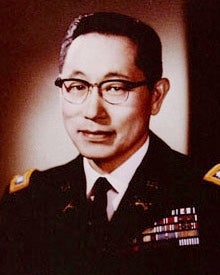Edward T. Chang at the statue of Dosan Ahn Chang Ho in downtown Riverside. (UCR/Stan Lim)
The Sweet Taste of Freedom
How the Korean independence movement began among Riverside orange pickers.
By Sandra Baltazar Martínez
A slice of Korean American history that had been overlooked for more than a century is now an officially documented part of citrus development in Riverside thanks to a book published earlier this year by Edward T. Chang, a professor of ethnic studies and founding director of UC Riverside’s Young Oak Kim Center for Korean American Studies. The book, “Pachappa Camp: The First Koreatown in the United States,” also asserts Korea’s democratic movement was born in Riverside. Chang chronicles the small community known as Pachappa Camp, where in the early 1900s many Koreans lived in what is now known as Riverside’s Eastside, near 14th and Commerce streets. The community was established by one of Korea’s most influential independence activists, Dosan Ahn Chang Ho.
“Pachappa Camp was not only the first Koreatown in America, but also the center of early Korean community and independence movement activities during the early 20th century,” Chang said. “This fills a void of modern Korean American and Korean history. Dosan Ahn Chang Ho is such a towering figure, and yet we didn’t know about this.”
Initially known as Dosan’s Republic, Pachappa Camp was founded sometime in late 1904 or early 1905. Ahn lived in Riverside more than five years, between 1904-07 and 1911-13, then moved his family to Los Angeles. Chang said most history books document Ahn’s history beginning in 1911. While in Riverside, Ahn established the Cooperative Association, which Chang said led to the idea of establishing the New People’s Association in Korea, which worked to promote Korean independence. The country was a monarchy before coming under Japanese rule in 1910.
During the early 1900s, Koreans came from San Francisco, Hawaii, and other parts of the country to work in Riverside’s citrus groves. They also founded homes in what is now Redlands, Claremont, and Upland. Pachappa Camp — a name derived from what was then Pachappa Avenue — was a settlement in a segregated part of the city with no electricity or running water. Year after year, the population grew, drawing new residents every orange harvest season. The settlement thrived, Chang said, growing to nearly 1,000 residents. Among his accomplishments while in Riverside, Ahn also created the Korean Labor Bureau; the Korean National Association of North America, Riverside chapter; and the Young Korean Academy, an association he also established in San Francisco in 1913 to develop leaders for an independent Korea.
“People tend to ignore Riverside or make it a footnote, but people should remember that Riverside was one of the most important historical sites of early Korean American history and pay tribute to our labor,” Chang said. Pachappa Camp became a historic Korea Town formally recognized by the City of Riverside in 2017. The Dosan Ahn Chang Ho memorial statue in downtown Riverside was dedicated in 2001. Chang spent five years researching English and Korean journals and newspapers for the book and made headway when two visiting Korean graduate interns translated articles written in old Korean.
“Many of these primary source materials are newly discovered and shed new light on not only the formation of Pachappa Camp, but more importantly uncover the buried past of early Korean American history,” Chang said.
Kim
Young Oak Kim Center for Korean American Studies
A $2.5 million grant from the Overseas Koreans Foundation helped establish the Young Oak Kim Center for Korean American Studies in 2010. The YOK Center, as it is known, is the only officially recognized Korean American studies center in the United States. The center aims to understand what it means to be a Korean American in the 21st century, the history of Korean Americans, and the Korean diaspora in the United States and around the world.
The center is named after Col. Young Oak Kim, who after nearly 30 years in the U.S. Army, retired in 1972 as the most decorated Asian American in the U.S. military. He was believed to be the only Korean American officer in a mostly Japanese American Army unit during World War II. According to the U.S. Army Reserve, while Kim fought in the Korean War, he and his battalion adopted an orphanage in Seoul, providing food and supplies for 500 orphans.
After his time in service, Kim dedicated his life to helping victims of domestic violence, victims of Japan’s sexual slavery, senior citizens, orphans, and others in vulnerable communities. In 1975, he helped establish the Koreatown Youth and Community Center in downtown Los Angeles and was deeply involved in creating other support programs for Asian communities. In California, a portion of Interstate 5 is dedicated in his honor.



